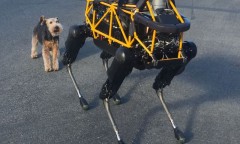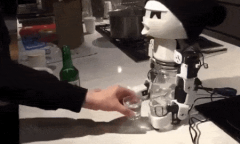By Steve Pak, | April 04, 2016

'Scarlett Johansson' Robot
A Hong Kong apartment was the workspace of an inventor who built a lifelike robot that seems to be inspired by Hollywood actress Scarlett Johansson. His pet project took one and a half years to complete and had a total cost of $50,000. The Mark I prototype is an android that includes a 3D printed skeleton and silicone skin that covers the electronic and mechanical parts that bring the machine to life.
Like Us on Facebook
42-year-old product and graphic designer Ricky Ma built the robot on his apartment balcony. He has not directly stated that the mechanical woman was modeled after Johansson but it is likely the Hollywood starlet who starred in films including "Lost in Translation" (2003), "Her" (2013), and the Avengers movies.
The robot is programmed to say basic phrases and perform simple movements after receiving verbal commands, according to Engadget.
Mark I can do many basic movements such as turning its head, moving its arms and legs, and bowing. The robot head with blonde hair and liquid eyes can also do complex facial expressions.
For example, the anthropomorphic machine can reply to hearing that it is beautiful. The eyes and eyebrows relax, the lips smile, and the machine says "thank you."
Ma shares that it was the right time to make his dream come true after watching robots in cartoons during his childhood, according to Reuters. The inventor taught himself fields such as robotics, programming, and electro-mechanics in order to build the electronic gadget.
However, Ma had to deal with some criticism as he built his robot. Some people said the cost was high, it was a difficult task, or that he was being stupid. The inventor still worked hard and used the trail-and-error method to deal with problems such as the electric motors burning out.
Ma has plans to sell the life-sized bot to an investor and build better humanoids in the future.
In related news, Microsoft's Twitter chatbox named Tay was pulled after making racist and Neo-Nazi tweets within 24 hours after going online. It brings up the issue of how robots can be programmed to make moral decisions, and whether humans can trust such machines. Two main options include writing code for "ethical laws" and building machine-learning robots that are taught about how to respond in different situations.
-
Use of Coronavirus Pandemic Drones Raises Privacy Concerns: Drones Spread Fear, Local Officials Say

-
Coronavirus Hampers The Delivery Of Lockheed Martin F-35 Stealth Fighters For 2020

-
Instagram Speeds Up Plans to Add Account Memorialization Feature Due to COVID-19 Deaths

-
NASA: Perseverance Plans to Bring 'Mars Rock' to Earth in 2031

-
600 Dead And 3,000 In The Hospital as Iranians Believed Drinking High-Concentrations of Alcohol Can Cure The Coronavirus

-
600 Dead And 3,000 In The Hospital as Iranians Believed Drinking High-Concentrations of Alcohol Can Cure The Coronavirus

-
COVID-19: Doctors, Nurses Use Virtual Reality to Learn New Skills in Treating Coronavirus Patients











